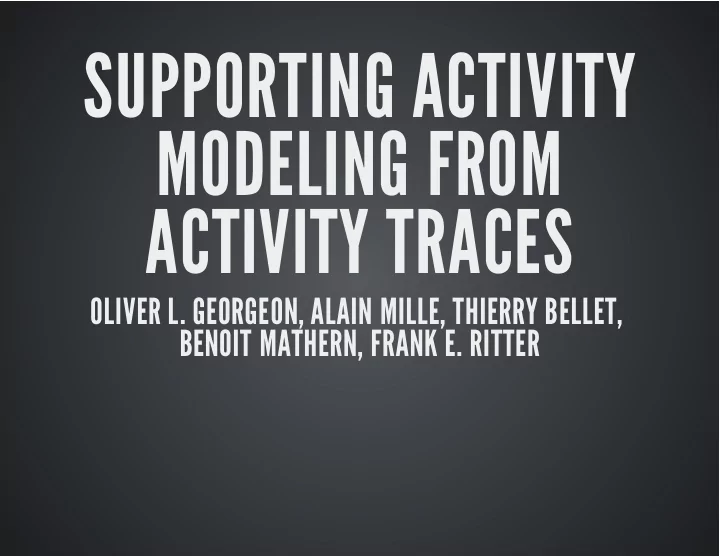

SUPPORTING ACTIVITY MODELING FROM ACTIVITY TRACES OLIVER L. GEORGEON, ALAIN MILLE, THIERRY BELLET, BENOIT MATHERN, FRANK E. RITTER
STRUCTURE 1. Introduction 2. Modeling activity traces 3. System implementation 4. Example Activity model 5. Related work 6. Conclusion
WHAT IS IT ALL ABOUT? 1. Raw 2. Symbolic 3. Modeled 4. Activity
ACTIVITY TRACES An activity is a meaningful inscription, from the viewpoint of an analyst, of the flow of what has happened, from the viewpoint of a subject.
Ø → RAW Recordings of Video Audio Sensor Computer logs Verbal cues
RAW → SYMBOLIC
SYMBOLIC → MODELED
MODELED → ACTIVITY
ABSTRACT Analysis of Behavior and Situation for menTal Representation Assessment and Cognitive acTivity modeling Modules: Collection Symbolic trace Documentation Technologies: RDF Resource Description Framework RDFS Resource Description Framework Schema XML Extensible Markup Language Protégé Ontology editor SVG Scalable Vector Graphic PHP PHP: Hypertext Preprocessor XSL Extensible Stylesheet Language SPARQL SPARQL Protocol and RDF Query Language
ABSTRACT
TRACE TRANSFORMATION CONSTRUCT (?r1, infer, Indicator_Symbol) (?r2, infer, Indicator_Symbol) (Indicator_Symbol, type, Lane_Change_Indicator) WHERE (?r1, type, Accelerate) (?r2, type, Left_Mirror_Glance) (?r1, time_code, ?d1) (?r2, time_code, ?d2) (?r2, Acceleration_Value, ?v1) FILTER ( ?v1 > 1) (sequence(?d1,?d2,1)) # in order, within 1 second
CONCLUSION AND FUTURE DEVELOPMENT RAW → SYMBOLIC → MODELED → ACTIVITY SIMULATE THE ACTIVITY
Recommend
More recommend